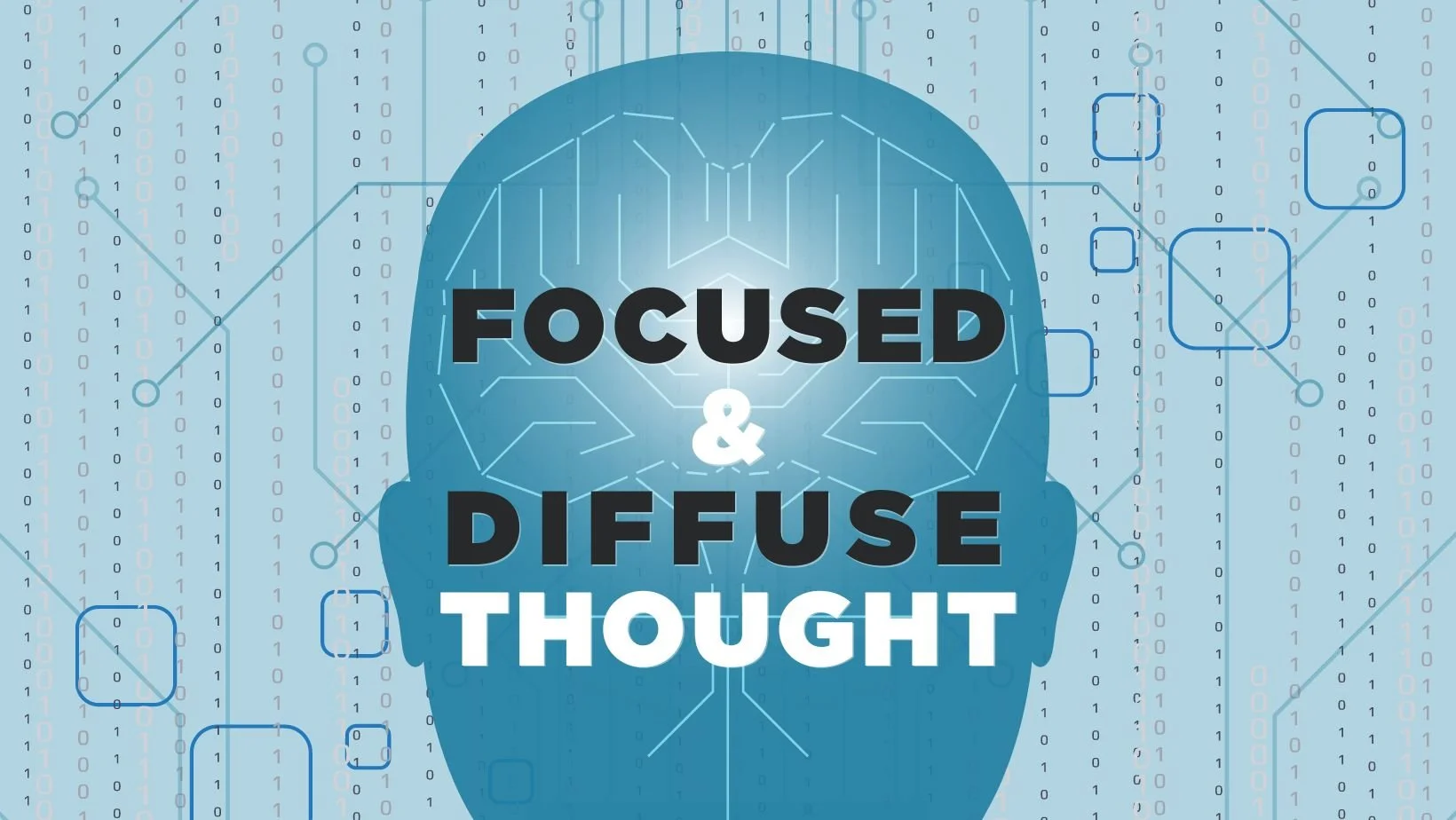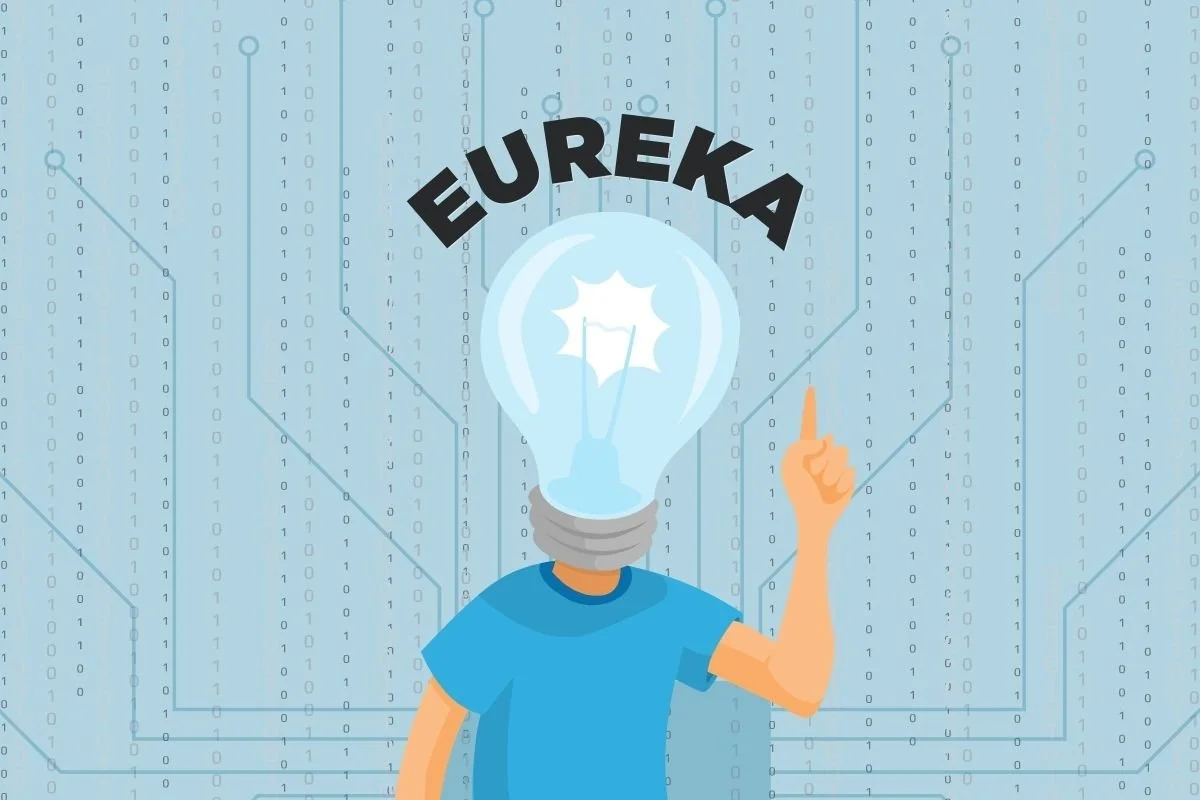Focused and Diffuse Thought
Let’s imagine that you’ve purchased a powerful, but very strange computer. This computer does all the usual things a computer does, you can get online, check your email, create documents, edit photos, anything you like.
But this computer has a special feature. When you let it idle, it performs complicated AI tasks in the background, and randomly spits out unique, creative, problem-solving solutions for any issues you’re having. These solutions are things you never would have come up with on your own. Using its deep trove of data, the computer makes unexpected connections that would never occur to you, no matter how much you worked on the problem at hand.
The thing is, the computer must be in idle mode for a while before you get these creative solutions. The moment you use the computer to check social media, watch a video, or input data, it becomes just another normal machine and won’t give you any of those cool, delightful, surprising answers to your problems.
If you had a computer like this, and it was the only computer you had access to, how would you use it?
You’d quickly figure out the smartest way to use the computer would be to get all your work and media browsing done in chunks, then give it plenty of time in idle mode so you could see what innovative solutions it came up with.
The worst way to use it would be to constantly interrupt its idle time to send a quick message, watch a cute cat video, or play a dumb minigame. This would be a huge waste of the computer’s potential to make your life better.
You’ve probably got a sneaking suspicion what this computer is referring to. The machine we’re talking about is the supercomputer sitting behind your eyes, reading these words right now — your incredible, supercharged, 100-teraflop brain.
When you read the history of scientific breakthroughs, you come across a common theme. The scientist or inventor is stuck on a tricky problem, and can’t seem to make headway. Frustrated, they take a walk, go out to lunch, or putter around in the garden.
It’s during these times of idleness that they have their eureka moment. Even though they’re not sitting at their work table, the brain is still chugging away at their work in the background. The difference is, when in idle mode, the brain is able to connect ideas in new ways, creating sparks of insight that open the doors of knowledge.
You’ve probably experienced this in your own life. You might be stuck on something, be it a family problem, an issue at work, or even something like how to beat a video game level or the answer to a puzzle. You bang your head against the wall, give up, shrug, and get on with your day. Then, when you’re in the middle of some kind of mindless activity, (walking, folding laundry, looking out the window at nothing), the solution quietly pops into your head, and you can’t wait to get back to work and put it into action.
Modern neuroscience has shown that this effect isn’t just a pretty idea, but a real phenomenon. Researchers describe the brain as having two thinking patterns — focused, and diffuse. When you’re working on a specific task, the brain is following established neural pathways it has learned in the past.
This is why it’s difficult to have creative, innovative thoughts when you’re in the focused state. Your neurons are staying in their lane, working smoothly and efficiently, but following preset patterns.
But when you’re not working on a particular task (or are doing a task like washing dishes that’s so routine you don’t need higher brain functions), your brain slips into the diffuse thinking mode. Your neurons have no particular path to follow, and start to branch out and make new connections.
Sometimes these new connections amount to nothing, just a random silly thought that comes and goes. But when you’ve got a sticky problem that’s occupying your mind, more often than not diffuse thinking will link up two neurons that you never connected before, and you’ll have a flash of insight. You might say, “Hmm… I’ve never thought of it that way…”, and you’re exactly right! It’s a novel neural pattern that opens up creative possibilities. If you’re the kind of person that wants to find new, out of the box solutions to the problems you face, diffuse thinking is a subtle but essential tool.
This is where the supercomputer analogy we started with comes into play.
For the first time in history, we live in a time where 24 hours a day you can reach into your pocket or onto the bedside table and find text, images, and media that fully occupy your attention. When you’re browsing a news site, contributing to a message group, or watching a video, even though it seems like you’re relaxing, your mind is in the focused state.
Nobody has ever had a diffuse-mind eureka moment while scrolling on their phone.
The trouble with the diffuse mental pattern is that, when you’re not used to it, it can feel uncomfortable. It can feel like boredom and restlessness. You can tell yourself you should be doing something more productive, something more outcome-oriented, something more focused. So you reach for your phone and find something to look at. The diffuse state is avoided and we get back to our comfort-zone of being in the focused mode.
We’re now two decades into the smartphone era, and for many of us, this tendency to reach for the phone during ANY moment of quiet inactivity has become like a nervous tic.
Waiting to meet someone at the coffee shop? Browse the top of your social media feed.
Chopping vegetables? Put on a podcast to make it less tedious.
Line at the supermarket? Check the latest news headlines.
Stopped at a red light? Have a quick glance at your text messages.
In this way we’re chipping away at every single moment of potential diffuse-thought during the day. We’re using the supercomputer in the worst possible way. How many creative, innovative solutions are slipping by as we whip the phone out of our pocket?
There’s a popular subreddit called “Shower Thoughts”. Shower thoughts are the random, funny, sometimes deep thoughts. The idea is that these are the kind of weird “out of left field” thoughts that often come to people while taking a shower. Here are some examples:
“In order to fall asleep, you have to pretend to be asleep.”
“Someone who says "I'll be there in 6 minutes" will normally arrive before someone who says "I will be there in 5 minutes.”
"Car horns should only be allowed to be in pitches C, E, and G, so whenever two people honk at the same time it will be in harmony and traffic jams will sound like symphonies.”
According to internet search history, the term “shower thought” only started being used around 2005, just about the time it became common to have an internet-connected phone with you at all times. Maybe, just maybe, shower thoughts are shower thoughts because the shower is one of the last places we’re guaranteed to not be able to use a device that interferes with diffuse thinking?
Wouldn’t it be nice to not only have shower thoughts in the few minutes a day that you shower? Putting the phone down helps that happen.
To sum up, if you want a life that’s full of creativity and innovation, either for your career or your own self-fulfillment, there are some changes you should consider:
1. Create time for diffuse thought
Make a conscious effort to spend at least half an hour a day away from any phone, computer, television, podcast, book, or other focus-driven media. You might feel this as boredom. You might feel like you could be doing something more productive. Resist the temptation to reach for something that puts you in focused mode. Enjoy the ability of your mind to float on the wind like a dandelion seed. Sometimes this half hour will lead to nothing, other times you might get a bright idea. That bright idea can end up as a new business enterprise, a time-saving method, or a rewarding creative pursuit. Isn’t that worth a half hour a day?
2. Capture ideas
When a new, interesting idea pops-up, capture it in a notebook, note-taking app, or voice memo. So many brilliant thoughts have been lost to history because people told themselves, “I don’t need to write this down, how could I forget such a good idea?” Why take that chance? Even if you’re not sure what to do with an interesting idea right now, you’ll be surprised how helpful they can be years later when you revisit them with more knowledge and wisdom.
3. Work out the idea with focused thinking
A diffuse-mind-idea is the spark, but hard, focused work is what nurtures that spark into a bonfire. Understand that 1% inspiration 99% perspiration isn’t just a catchy business phrase, but how things actually work. The diffuse-mind and the focused-mind are a pair that need each other, but it’s the focused-mind that does the heavy lifting.
4. Sow the seeds of innovation with a diverse intellectual “diet”
Your diffuse-brain can only connect interesting, varied thoughts if there are interesting, varied thoughts in the brain to begin with. The more exposure you have to fresh information and perspectives, the more fertile the mind is for diffuse-thinking rewards. Everyone has their speciality, but be sure you’re supplementing it with plenty of outside the box content to make the most of your supercomputer.
5. Sleep
The brain is severely compromised when you haven’t gotten enough sleep. If being creative and innovative is important to you, prioritize those things which promote good rest with good sleep hygiene.
6. Exercise
We sometimes see ourselves as a brain in a jar, able to sit and think well no matter what’s going on with the rest of our body. But to work its best, the brain is depending on dozens of hormones to be in the right balance at the right time. Exercise is one of the best ways to get this calibration right. A good sweaty exercise session hits the reset button on the endocrine system and sets your brain up for productive thought, both focused and diffuse.
7. Cardio is here to save the day.
For most people, the idea of setting aside a half hour daily to purposely do nothing feels daunting. When you’re busy and stressed, it’s so tempting to try and force productivity by multitasking during boring activities.
We have good news for you! You can multitask diffuse-thinking too. As discussed, any “mindless” activity like dishes or laundry is a good chance to let the mind wander into productive diffuse thought, so don’t always fill the space with television, radio, or podcasts. However, there’s one even more impactful way to multitask — through a daily cardio session.
Activities like walking, hiking, jogging, cycling, rowing, or using any kind of exercise machine are all repetitive motions which your higher brain doesn’t need to be tuned in for. Don’t always smother these times with background media. Try doing your cardio “naked,” without screens or headphones and see what interesting ideas bubble up as you work. Just be sure to capture the ideas when your cardio session is over!
When encouraging people to allow time and space for diffuse thinking, we often find people don’t really trust their brains to produce these innovative ideas. People have reactions like:
“Why would I want to just sit around doing nothing, I’m busy!”
“I’m not a creative person, this won’t work for me.”
“I’m just going to feel bored.”
Don’t listen to these excuses. The human brain is a miracle of nature. Give it some credit. Trust that if you let it relax and open up neurons will start to connect, and you’ll be better off for it. A life spent entirely in focused mode is little different than an assembly line robot completing a task thousands of times. The beauty and genius of humanity happens in those subtle times of diffuse-thought.
Don’t deny yourself the bounty of your wonderful brain. Put the phone down for just 30 minutes a day! We can’t wait to hear what creative, new ideas bubble up from the new, unexpected neural connections you’ll be making!














